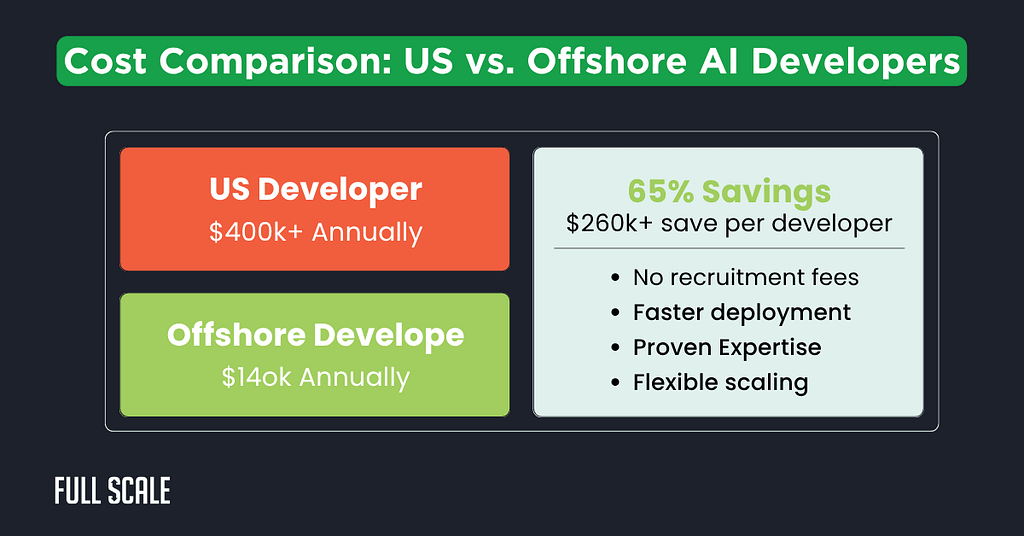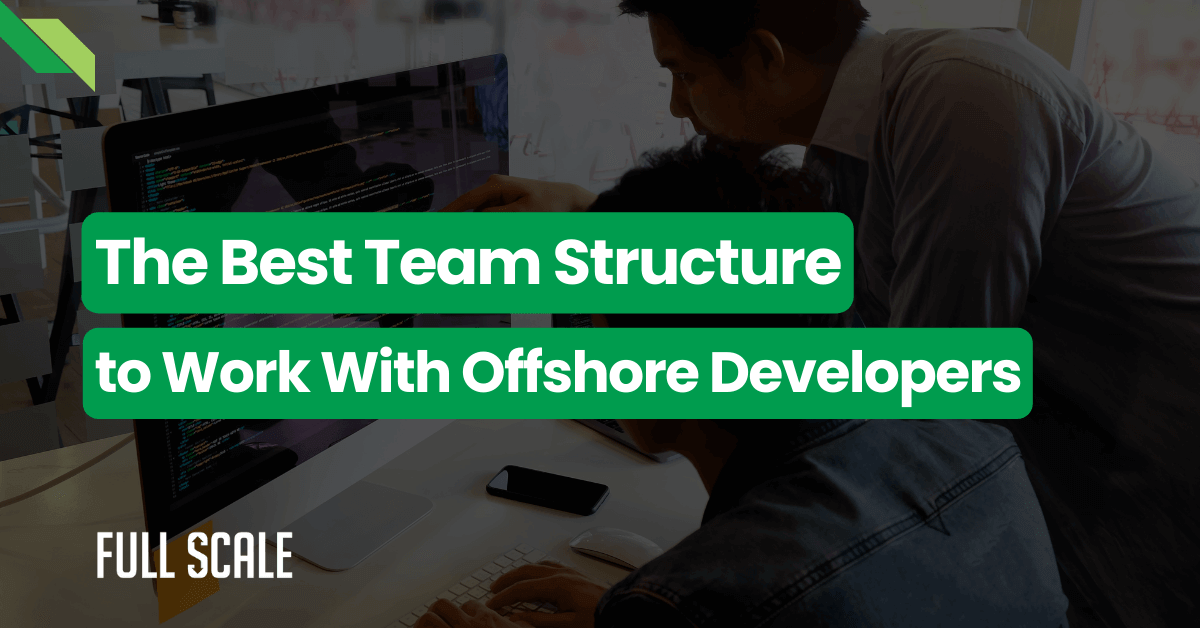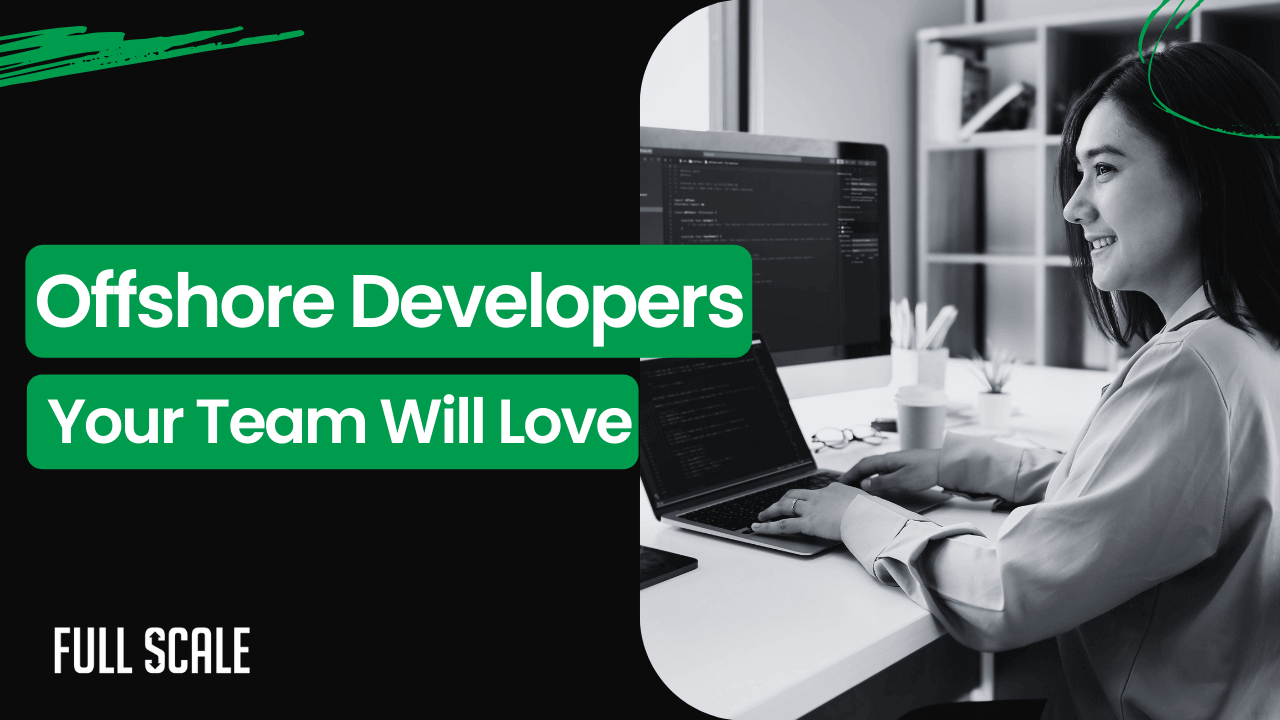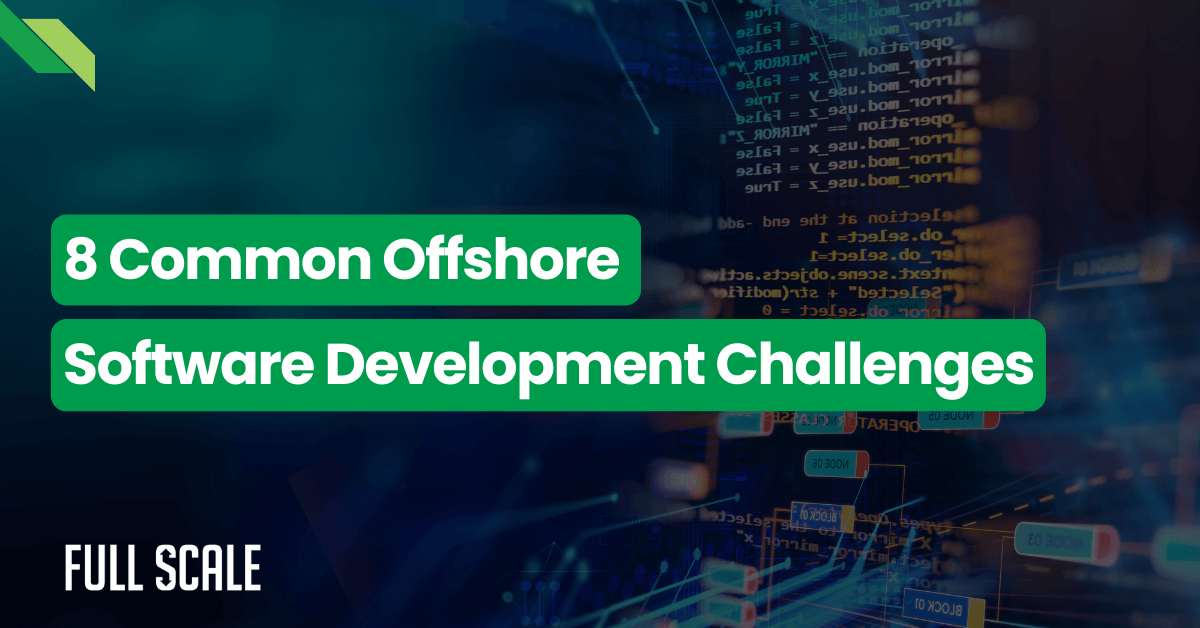What is the AI developer shortage? The AI developer shortage is a critical talent gap where 4.2 million AI positions remain unfilled globally, while only 320,000 qualified developers are available.
This shortage costs companies an average of $2.8 million annually in delayed AI initiatives and has reached crisis levels in 2025.
According to recent research by McKinsey Global Institute (2024), the global AI talent gap has expanded dramatically, while CompTIA’s 2024 Tech Workforce Report reveals that 87% of organizations struggle to hire AI developers, with average time-to-fill reaching 142 days.
AI Developer Shortage Key Statistics (2025)
| Metric | Impact |
| Global unfilled AI positions | 4.2 million |
| Available qualified developers | 320,000 |
| Companies struggling to hire AI talent | 87% |
| Average time to fill AI positions | 142 days |
| Annual cost per company in delays | $2.8 million |
| AI developer salary increases year-over-year | 32% |
Why is There an AI Developer Shortage?
Primary causes driving the AI talent crisis:
- Supply-demand imbalance: Universities produce 40% fewer AI-ready graduates than market demand
- Skill obsolescence: AI technologies evolve so rapidly that skills become outdated within 15 months
- Geographic concentration: 65% of qualified AI developers are concentrated in only 5 metropolitan areas
- Big Tech absorption: FAANG companies hire 70% of top AI talent directly from universities
Industries Most Affected by AI Developer Shortage
- FinTech: 94% report critical AI talent gaps
- HealthTech: 89% struggle with AI implementation delays
- E-commerce: 91% face AI development bottlenecks
- Manufacturing: 76% cannot scale AI initiatives
Bottom Line: The AI developer shortage has created a perfect storm where growing demand meets shrinking supply, forcing companies to compete aggressively for limited talent or explore alternative solutions like offshore development teams.
The Data Behind the AI Developer Shortage Crisis
Understanding the full scope of the AI developer shortage requires analyzing both quantitative metrics and qualitative factors driving this unprecedented talent crisis. Current market research reveals the true scope of the artificial intelligence developer demand crisis affecting global markets.

Market Demand vs. Supply Gap Analysis
The mathematics of the AI talent shortage tells a compelling story of explosive demand meeting limited supply. The software developer shortage has created 1.6 million unfilled positions worldwide, representing an 85% year-over-year increase in AI job postings. Companies now average 142 days to hire AI developers versus 52 days for general software developers.
Critical AI Skills Shortage Statistics
- AI developer salaries are rising 32% annually due to competition
- Senior AI engineer shortage affects 94% of technology companies
- Machine learning talent crisis impacts companies regardless of size
- Global AI talent shortage statistics show 78% of startups cannot scale AI teams
Geographic and Skills Distribution Problems
The AI talent shortage isn’t uniformly distributed—certain specializations and geographic regions face more severe shortages than others. AI talent concentration creates significant challenges, with 65% of qualified developers in five metropolitan areas. The AI engineering talent gap is most severe in specialized domains:
| AI Specialization | Shortage Rate | Average Salary | Time to Fill |
| Computer Vision | 96% | $265,000 | 167 days |
| MLOps Engineering | 89% | $235,000 | 145 days |
| NLP Specialists | 94% | $255,000 | 158 days |
| AI Product Management | 87% | $210,000 | 132 days |
How to Solve the AI Developer Shortage: A Step-by-Step Guide
Smart companies are moving beyond traditional hiring approaches to implement systematic solutions that work in today’s competitive market. This comprehensive framework provides actionable strategies for building AI teams within weeks, not months.
Immediate Actions (Week 1-2)
The first phase of solving your AI developer shortage requires strategic assessment and option evaluation. Taking the right initial steps sets the foundation for successful AI team scaling.
Step 1: Assess Your AI Talent Needs
- Audit current capabilities: List existing AI skills on your team
- Define skill gaps: Identify specific AI expertise needed (Computer Vision, NLP, MLOps)
- Calculate budget impact: Determine the cost of delays vs. hiring solutions
- Set timeline goals: Establish realistic deployment schedules
Step 2: Evaluate Hiring Options
- Traditional hiring: Average 142 days, costs $85,000+ per hire
- Freelance platforms: Quick access, but quality varies significantly
- Offshore teams: 2-3 week deployment, 65-75% cost savings
- Team augmentation: Hybrid approach with fastest time-to-productivity
Short-term Solutions (Week 3-8)
Once you’ve completed your assessment, these two proven approaches offer the fastest path to productive AI development capacity. Each option serves different company situations and risk tolerance levels.
Option A: Offshore AI Development Teams
Best for: Companies needing immediate AI talent access
- Timeline: 2-3 weeks to full productivity
- Cost savings: 65-75% vs US-based developers
- Quality assurance: Pre-vetted talent with proven track records
- Scalability: Easy team scaling up/down based on project needs
Option B: AI Developer Team Augmentation
Best for: Companies with some internal AI expertise
- Knowledge transfer: Offshore experts work alongside internal teams
- Risk mitigation: Try-before-you-buy approach
- Flexible engagement: Project-based or long-term partnerships
- Faster onboarding: 78% faster than traditional hiring
Long-term Strategy (Month 3+)
Building sustainable AI capabilities requires strategic thinking beyond immediate hiring needs. These foundational elements ensure scalable growth and competitive advantage over time.
Build Sustainable AI Talent Pipeline
- Partner with proven providers: Establish relationships with pre-vetted offshore teams
- Implement hybrid models: Combine local AI leadership with offshore execution
- Create knowledge bases: Document processes for easier team scaling
- Plan for growth: Build frameworks that support rapid AI team expansion
Why the AI Developer Shortage is Actually a Quality Problem, Not a Quantity Problem
The conventional wisdom about the AI developer shortage misses a crucial insight that changes everything about hiring strategy. While everyone focuses on the numbers, the real issue lies in the dramatic gap between claimed expertise and actual production capabilities.
The Experience Paradox in AI Talent Acquisition
The gap between AI developer resumes and actual production experience has reached crisis proportions, creating costly hiring mistakes. Research shows 76% of candidates claiming AI expertise lack production-level experience. A Fortune 500 company’s recent AI architect search involved 267 candidates over nine months, with only three demonstrating required capabilities.
Assessment Challenges in AI Developer Recruitment
- 76% of “AI developers” have never deployed a model to production at scale
- Only 12% understand MLOps pipeline architecture beyond basic training
- 68% cannot optimize model performance for real-world constraints (latency, memory, cost)
- Junior developers overselling AI capabilities during interviews
- Skills become obsolete within 15-month cycles
- Standard coding interviews fail to evaluate machine learning implementation
Strategic Insight: Companies should focus on finding developers with production AI experience rather than expanding the candidate pool with theoretical knowledge.
The Hidden Geographic AI Talent Redistribution
While most companies fight over the same limited talent pools in traditional tech hubs, emerging markets are quietly producing world-class AI expertise. Understanding this geographic shift reveals untapped opportunities for cost-effective talent acquisition.
Tier 1 Emerging Markets (High quality, moderate cost):
- Bangalore, India: 40% of global AI research papers, 65% cost savings
- Krakow, Poland: Strong computer vision expertise, EU timezone alignment
- Buenos Aires, Argentina: Growing fintech AI specialization, US timezone overlap
Tier 2 Emerging Markets (Excellent quality, maximum savings):
- Lviv, Ukraine: 90% of developers have advanced degrees, 70% cost savings
- Ho Chi Minh City, Vietnam: Rapid government investment in AI education, 75% cost savings
- Medellín, Colombia: Growing reputation for AI/ML expertise, perfect US timezone alignment
Where to Find AI Developers Fast: 4 Proven Sources
Traditional recruitment channels fail when speed and quality both matter, but these four proven approaches consistently deliver results. Each source offers distinct advantages depending on your timeline, budget, and team integration requirements.
1. Offshore AI Development Teams (2-3 weeks)
Geographic arbitrage combined with rigorous vetting processes creates the fastest path to qualified AI talent.
Success Rate: 94% for companies needing immediate deployment
- Pre-vetted talent pools with rigorous screening processes
- Established providers with 500+ successful AI projects
- Geographic arbitrage offers 65-75% cost savings
2. AI Team Augmentation Partners (1-2 weeks)
Hybrid models that blend offshore expertise with local oversight deliver the best of both worlds for many organizations.
Success Rate: 89% for hybrid team models
- Fastest time-to-productivity approach
- Try-before-you-buy evaluation periods
- Knowledge transfer opportunities for internal teams
3. Specialized AI Recruitment Firms (8-12 weeks)
When you need senior-level talent and have time for thorough vetting, specialized recruiters offer access to passive candidates.
Success Rate: 67% for senior-level positions
- Deep networks in AI talent communities
- Technical assessment capabilities
- Higher success rates than general recruiters
4. University AI Research Partnerships (12-16 weeks)
Academic partnerships provide access to cutting-edge expertise while supporting the next generation of AI talent.
Success Rate: 78% for long-term hires
- Access to cutting-edge research talent
- Internship-to-hire conversion programs
- Lower cost compared to market rates
Cost of Hiring AI Developers: Complete 2025 Breakdown
Understanding the true cost of AI talent requires looking beyond base salaries to include hidden expenses and opportunity costs. This comprehensive analysis reveals why offshore development has become financially compelling for most organizations.

AI Developer Salary Costs by Location
Geographic location dramatically impacts total compensation packages, with offshore markets offering substantial savings without compromising quality.
| Role | US Annual Cost | Offshore Annual Cost | Savings |
| Senior AI Engineer | $265,000 | $95,000 | 64% |
| ML Ops Specialist | $235,000 | $85,000 | 64% |
| Computer Vision Expert | $285,000 | $98,000 | 66% |
| AI Product Manager | $210,000 | $75,000 | 64% |
Hidden Costs in AI Developer Hiring
The published salary figures represent only the tip of the iceberg when calculating true AI talent acquisition costs. These often-overlooked expenses can double your actual investment in AI team building.
Direct Hiring Costs
- Recruitment fees: $85,000 average per successful hire
- Signing bonuses: $175,000+ for senior AI talent
- Relocation expenses: $45,000 average for out-of-area hires
- Training and onboarding: $25,000 per developer
Opportunity Costs
- Project delays: $2.8M average revenue loss per delayed AI initiative
- Competitive disadvantage: Companies without AI fall behind by 28 months
- Technical debt: 71% of rushed AI implementations require refactoring
Total Cost Analysis: The offshore AI development ROI becomes compelling as domestic costs rise, offering 65-75% savings while maintaining quality standards through rigorous vetting processes.
Machine Learning Team Scaling: Strategic Framework
Successful AI team building requires systematic planning across multiple phases to avoid common pitfalls that derail projects. This proven framework has helped hundreds of companies scale from zero to productive AI development teams.
Phase 1: Assessment (Week 1-2)
Proper assessment prevents costly mistakes and ensures alignment between AI talent acquisition and business objectives. Most failed AI initiatives trace back to inadequate initial planning.
Key Activities
- Skills gap analysis and capability mapping
- Budget planning and ROI projections
- Timeline establishment and milestone definition
Success Metrics
- Clear requirements documentation
- Stakeholder alignment across departments
- Approved budget and resource allocation
Phase 2: Sourcing (Week 2-4)
Effective sourcing combines multiple channels while maintaining rigorous quality standards throughout the selection process. The key is balancing speed with thorough technical evaluation.
Key Activities
- Multi-channel AI talent acquisition
- Technical assessment and cultural fit evaluation
- Contract negotiation and team composition
Success Metrics
- Qualified candidate pipeline establishment
- Technical competency validation
- Cost-effective team structure design
Phase 3: Integration (Week 4-8)
Smooth team integration determines whether your AI talent investment delivers immediate value or struggles with communication and process alignment. Getting this phase right accelerates time-to-productivity dramatically.
Key Activities
- Team onboarding and process alignment
- Communication framework establishment
- Initial project assignment and monitoring
Success Metrics
- Productive AI development team deployment
- Effective cross-timezone collaboration
- Meeting initial project milestones
Phase 4: Optimization (Ongoing)
Continuous improvement ensures your AI team investment delivers long-term value and competitive advantage. Most companies stop at integration, missing opportunities for substantial performance gains.
Key Activities
- Performance monitoring and feedback loops
- Process refinement and tool optimization
- Long-term partnership development
Success Metrics
- Consistent delivery velocity improvements
- Quality metrics maintenance
- Team satisfaction and retention rates
The AI Developer Shortage Will Solve Itself by 2027—Here’s Why
While the current AI talent crisis feels permanent, three major technological and educational shifts will dramatically reshape the landscape within 24 months. Understanding these trends helps companies make strategic talent decisions that position them for long-term success.
Prediction 1: AI-Assisted Development Will 10x Productivity
Developer productivity tools are evolving from simple code completion to comprehensive AI pair programming that handles complex implementation tasks. GitHub Copilot and similar tools have already increased AI development speed by 40%.
- By 2026, AI-powered code generation will handle 70% of routine ML implementation
- Impact: One experienced AI developer will effectively do the work of 3-4 current developers
Prediction 2: No-Code/Low-Code AI Platforms Will Democratize Development
The democratization of AI development through intuitive platforms will enable non-technical professionals to build sophisticated AI solutions. Platforms like Hugging Face AutoTrain and Google AutoML are becoming production-ready.
- Business analysts will build 60% of AI solutions without traditional programming
- Impact: Demand will shift from AI developers to AI solution architects
Prediction 3: University Curricula Will Finally Catch Up
Educational institutions are rapidly adapting to industry demands, with new programs focused on practical AI implementation rather than theoretical foundations.
Partnership between tech companies and universities will produce 200% more production-ready graduates by 2027.
- Bootcamps focused on AI implementation (not theory) will graduate 50,000+ developers annually
- Impact: The talent pipeline will saturate by late 2027
What This Means for Your AI Talent Strategy Today
These future trends create strategic opportunities for companies that act thoughtfully rather than reactively to current market conditions.
- Short-term (2025-2026): Double down on offshore talent and team augmentation
- Medium-term (2026-2027): Invest in upskilling existing developers with AI-assisted tools
- Long-term (2027+): Focus on AI strategy and architecture roles rather than implementation
The Full Scale Solution: Your AI Developer Shortage Answer
When companies need proven results rather than experimental approaches, Full Scale’s systematic methodology consistently delivers productive AI teams within weeks.
Our comprehensive solution addresses every aspect of the AI talent shortage through battle-tested processes and pre-vetted expertise.
Pre-Vetted AI Expertise
Quality assurance separates successful AI implementations from costly failures, which is why Full Scale maintains the industry’s most rigorous screening standards. Full Scale’s rigorous screening ensures that qualified AI developers join client teams. Technical assessments evaluate practical machine learning implementation beyond theoretical knowledge.
Quality Assurance Metrics
- Only 3% of AI developer applicants pass comprehensive evaluations
- 500+ successful AI projects across multiple industries
- Quarterly training updates on the latest AI frameworks
- Domain expertise in FinTech, HealthTech, and E-commerce
Rapid Deployment Model
Speed without sacrificing quality defines Full Scale’s approach to AI team integration and productive deployment. A two-week onboarding process enables quick transition from contract to productive AI development. Full Scale’s established procedures eliminate typical startup delays.
Deployment Advantages
- Add qualified AI developers within 48 hours of the request
- Seamless integration with US-based company teams
- Dedicated AI project managers and code review processes
- 90% reduction in onboarding time vs. traditional approaches
Client Success Stories
Real results from actual implementations demonstrate Full Scale’s ability to solve complex AI talent challenges across diverse industries and company sizes.
- FinTech Startup Case Study: “We reduced our AI feature development time from 8 months to 3 months by partnering with Full Scale’s pre-vetted AI team. The ROI was immediate—we launched ahead of competitors and captured 23% market share in our category.”—Sarah C., CTO
- E-commerce Platform Results: “Finding senior computer vision engineers locally would have taken 6+ months. Full Scale delivered a complete team in 3 weeks. Our image recognition features are now processing 2M+ transactions monthly.”—Michael R., VP of Engineering
Success Metrics to Track for AI Team Integration
Measuring the right metrics ensures your AI talent investment delivers measurable business value rather than just technical output. These key performance indicators help optimize team performance and justify continued investment in offshore AI development.
Development Velocity Metrics
Tracking productivity improvements helps quantify the impact of your AI talent acquisition strategy on actual project delivery.
- Time from AI talent acquisition to first productive output
- Feature delivery timeline improvements
- Code quality and technical debt reduction
- Sprint velocity improvements post-integration
Financial Performance Indicators
ROI measurement validates your AI talent strategy and provides data for scaling successful approaches across additional projects.
- Total cost of AI talent acquisition vs. budget
- ROI on AI initiatives compared to internal hiring costs
- Revenue impact from faster AI feature deployment
- Cost per feature delivered with offshore teams
Team Integration Success
Measuring collaboration effectiveness ensures sustainable, long-term partnerships that continue delivering value over time.
- Communication effectiveness across time zones
- Knowledge transfer completion rates
- Long-term retention of offshore AI partners
- Internal team satisfaction with augmented capabilities
Pro Tip: Start with a small pilot project (2-3 offshore AI developers) to test team dynamics before scaling to full AI product development teams.
Act Fast: The AI Developer Shortage Window Is Closing
Market dynamics are shifting rapidly, and the companies that secure AI talent access today will maintain competitive advantages for years to come. The AI developer shortage represents an urgent challenge intensifying through 2026. Organizations delaying action risk permanent competitive disadvantages as AI capabilities become standard expectations.
Market Urgency Factors
The window for cost-effective AI talent acquisition is narrowing as more companies recognize offshore development as a strategic solution. Industry projections show the AI developer shortage worsening by 40% over the next 18 months despite increased university enrollment. Companies with established AI teams maintain 22-month leads over competitors still building capabilities.
Critical Timeline Pressures
- AI architect hiring challenges are increasing as demand outpaces supply
- Cost trajectories project 45% salary increases by 2026
- The window for cost-effective AI talent acquisition is narrowing rapidly
- First-mover advantages in talent acquisition provide lasting benefits
Your Strategic Action Plan
Immediate Steps (Next 30 Days)
- Assess your AI talent gap and capability requirements
- Research offshore AI development partners with proven track records
- Start pilot AI projects to test team dynamics
- Evaluate AI talent acquisition budget allocation
Rapid Scaling (60-90 Days)
- Implement chosen AI talent acquisition strategies
- Scale successful partnerships for full AI product development team
- Optimize AI team integration strategies for maximum productivity
- Monitor performance metrics and adjust approaches
Secure Your AI Future Now
The AI developer shortage costs companies millions in lost opportunities and delayed competitive positioning. Organizations cannot afford to wait while talent becomes scarcer and more expensive.
Full Scale provides immediate access to pre-vetted AI developers who begin productive work within two weeks. This rapid deployment eliminates extended timelines associated with traditional hiring approaches.
Ready to solve your AI developer shortage? Hire the best software developers and build your AI team in weeks, not months. Full Scale’s proven approach addresses AI talent shortage challenges while delivering cost-effective excellence for growing technology companies.
Market leaders recognize that AI talent acquisition represents a strategic imperative that cannot be delayed. Act now to secure AI development capabilities or fall permanently behind competitors who move faster.
Explore Our Offshore Development Services
FAQs: AI Developer Shortage
What is the AI developer shortage, and why is it happening?
The AI developer shortage refers to the critical gap between the demand for qualified artificial intelligence developers and available talent. Currently, there are 4.2 million unfilled AI positions globally, with only 320,000 qualified developers available.
Primary causes include:
- Universities are producing 40% fewer AI-ready graduates than the market demand
- Rapid AI technology evolution is making skills obsolete within 15 months
- FAANG companies are absorbing 70% of top AI talent from university programs
- Only 22% of computer science graduates have practical AI experience
Is there a developer shortage specifically in specialized AI fields?
Yes, the software developer shortage is most severe in specialized AI domains. The global AI talent pipeline cannot meet current demand across key specializations.
Shortage rates by specialization:
- Computer Vision: 96% shortage rate
- Natural Language Processing: 94% shortage rate
- MLOps Engineering: 89% shortage rate
- AI Product Management: 87% shortage rate
These shortages create average hiring timelines of 145-167 days compared to 52 days for general software developers.
Where to find AI developers fast when traditional hiring fails?
Companies exploring where to find AI developers fast should consider offshore AI development teams and strategic partnerships with established providers.
Fastest solutions include:
- Offshore markets: Eastern Europe and Latin America produce 45% more AI graduates per capita
- Team augmentation: Access specialized expertise within 2-3 weeks vs. months
- Pre-vetted talent pools: Established providers with rigorous screening processes
- Hybrid approaches: Combine local leadership with offshore AI developers
How does the AI developer shortage impact business costs and timelines?
The AI developer shortage creates significant financial and operational impacts across multiple business areas.
Direct financial impacts:
- $2.8M average revenue loss per delayed AI project
- $85,000 average cost per successful AI developer hire
- 185% higher compensation compared to general developers
- 45% additional costs from recruitment fees and retention bonuses
Timeline consequences:
- Companies without AI fall behind competitors by 28 months
- AI project implementations take 240% longer than projected
- 71% of product managers report AI feature delays due to talent shortage
What are the best AI talent acquisition strategies for 2025?
Successful AI talent acquisition strategies combine multiple approaches to overcome the AI developer shortage while managing costs and timelines effectively.
Top strategies include:
- Geographic arbitrage: Leverage offshore AI development ROI with 65-75% cost savings
- Team augmentation: Reduce time-to-productivity by 78% compared to traditional hiring
- Specialized partnerships: Access domain expertise in FinTech, HealthTech, E-commerce
- Hybrid models: Maintain strategic control while scaling execution capacity
These approaches enable companies to build AI product development teams within weeks rather than months.
How can Full Scale solve my AI developer shortage challenges?
Full Scale addresses the AI developer shortage through comprehensive offshore development solutions designed specifically for growing technology companies facing an AI skills shortage.
Full Scale advantages:
- Pre-vetted expertise: Only 3% of AI developer applicants pass our comprehensive assessments
- Rapid deployment: Add qualified AI developers within 48 hours of request
- Cost efficiency: 65% savings compared to US-based AI talent acquisition
- Proven results: 500+ successful AI projects across multiple industries
Ready to solve your AI developer shortage? Hire the best software developers and access pre-vetted AI talent that begins productive work within two weeks.

Matt Watson is a serial tech entrepreneur who has started four companies and had a nine-figure exit. He was the founder and CTO of VinSolutions, the #1 CRM software used in today’s automotive industry. He has over twenty years of experience working as a tech CTO and building cutting-edge SaaS solutions.
As the CEO of Full Scale, he has helped over 100 tech companies build their software services and development teams. Full Scale specializes in helping tech companies grow by augmenting their in-house teams with software development talent from the Philippines.
Matt hosts Startup Hustle, a top podcast about entrepreneurship with over 6 million downloads. He has a wealth of knowledge about startups and business from his personal experience and from interviewing hundreds of other entrepreneurs.




